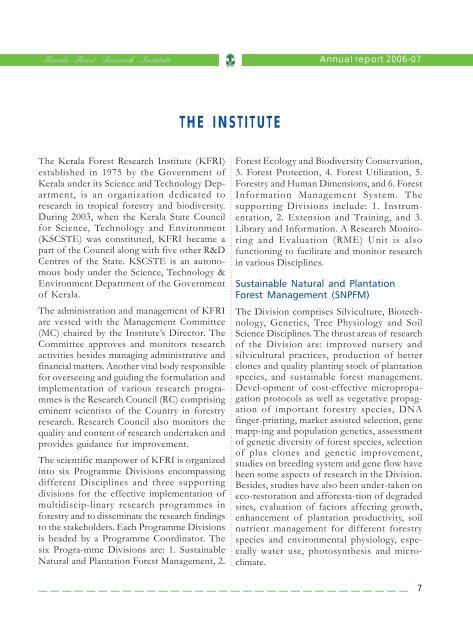2006-07 - Kerala Forest Research Institute
2006-07 - Kerala Forest Research Institute
2006-07 - Kerala Forest Research Institute
- No tags were found...
You also want an ePaper? Increase the reach of your titles
YUMPU automatically turns print PDFs into web optimized ePapers that Google loves.
<strong>Kerala</strong> <strong>Forest</strong> <strong>Research</strong> <strong>Institute</strong>Annual report <strong>2006</strong>-<strong>07</strong>...................................................................................................................................................................................The <strong>Kerala</strong> <strong>Forest</strong> <strong>Research</strong> <strong>Institute</strong> (KFRI)established in 1975 by the Government of<strong>Kerala</strong> under its Science and Technology Department,is an organization dedicated toresearch in tropical forestry and biodiversity.During 2003, when the <strong>Kerala</strong> State Councilfor Science, Technology and Environment(KSCSTE) was constituted, KFRI became apart of the Council along with five other R&DCentres of the State. KSCSTE is an autonomousbody under the Science, Technology &Environment Department of the Governmentof <strong>Kerala</strong>.The administration and management of KFRIare vested with the Management Committee(MC) chaired by the <strong>Institute</strong>’s Director. TheCommittee approves and monitors researchactivities besides managing administrative andfinancial matters. Another vital body responsiblefor overseeing and guiding the formulation andimplementation of various research programmesis the <strong>Research</strong> Council (RC) comprisingeminent scientists of the Country in forestryresearch. <strong>Research</strong> Council also monitors thequality and content of research undertaken andprovides guidance for improvement.The scientific manpower of KFRI is organizedinto six Programme Divisions encompassingdifferent Disciplines and three supportingdivisions for the effective implementation ofmultidiscip-linary research programmes inforestry and to disseminate the research findingsto the stakeholders. Each Programme Divisionsis headed by a Programme Coordinator. Thesix Progra-mme Divisions are: 1. SustainableNatural and Plantation <strong>Forest</strong> Management, 2.THE INSTITUTE<strong>Forest</strong> Ecology and Biodiversity Conservation,3. <strong>Forest</strong> Protection, 4. <strong>Forest</strong> Utilization, 5.<strong>Forest</strong>ry and Human Dimensions, and 6. <strong>Forest</strong>Information Management System. Thesupporting Divisions include: 1. Instrumentation,2. Extension and Training, and 3.Library and Information. A <strong>Research</strong> Monitoringand Evaluation (RME) Unit is alsofunctioning to facilitate and monitor researchin various Disciplines.Sustainable Natural and Plantation<strong>Forest</strong> Management (SNPFM)The Division comprises Silviculture, Biotechnology,Genetics, Tree Physiology and SoilScience Disciplines. The thrust areas of researchof the Division are: improved nursery andsilvicultural practices, production of betterclones and quality planting stock of plantationspecies, and sustainable forest management.Devel-opment of cost-effective micropropagationprotocols as well as vegetative propagationof important forestry species, DNAfinger-printing, marker assisted selection, genemapp-ing and population genetics, assessmentof genetic diversity of forest species, selectionof plus clones and genetic improvement,studies on breeding system and gene flow havebeen some aspects of research in the Division.Besides, studies have also been under-taken oneco-restoration and afforesta-tion of degradedsites, evaluation of factors affecting growth,enhancement of plantation productivity, soilnutrient management for different forestryspecies and environmental physiology, especiallywater use, photosynthesis and microclimate.7
















